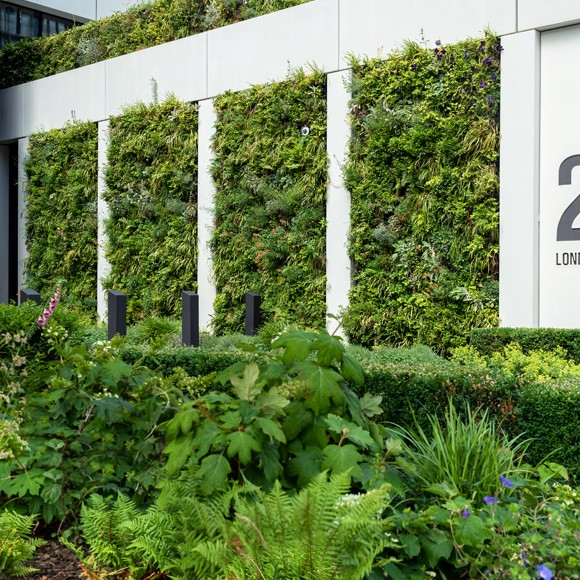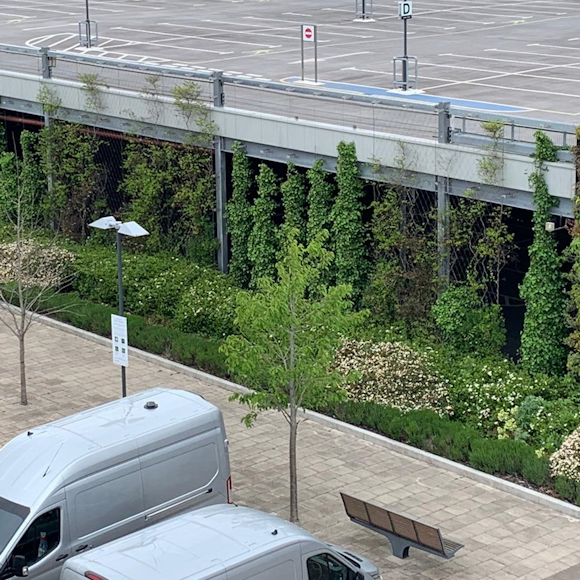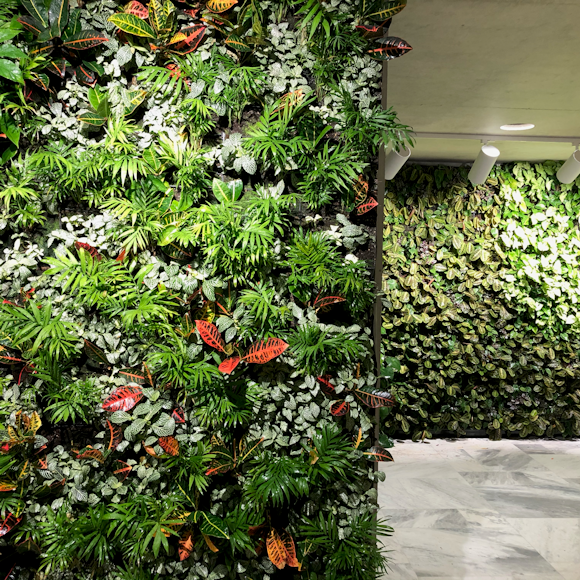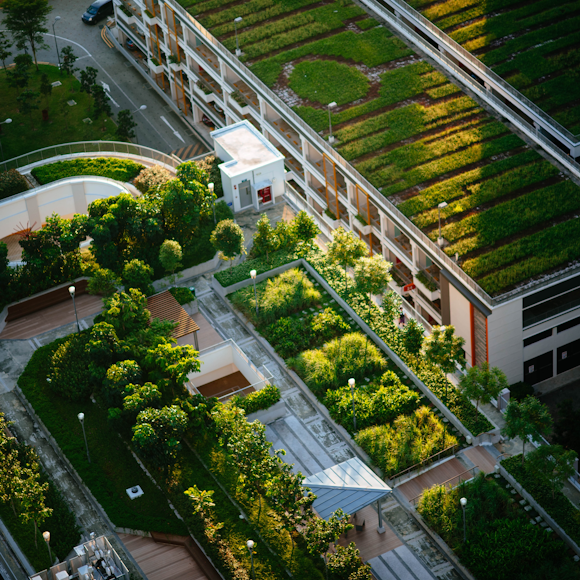Architects, you are the people we work with the most. In fact, we work alongside people in your profession every day. This means we know the questions you like to ask us about living walls! We brought the team together and came up with what we think are the top 20 questions, but this is by no means an exhaustive list. Please give us a call or email us at enquiries@ans.global to get an answer on any we’ve missed. Let’s get started:
1. What is your living wall fire rating?
The Viritopia Living Wall System has achieved a fire rating of B,s2-d0, as tested to BS EN 13501-1. This is the highest rating possible for a living wall system.
Be aware of systems that claim to have a Class A rating. These are often misleading, as only components of the system have been tested (without the plants and substrate), so not representing the reality of the finished build-up.
To find where living walls can and can’t be used, read this blog which covers all you need to know about living wall fire regulations. You could also join us for our live fire focused CPD: How and Where to Design a Living Wall to Meet Fire Regulations. Check out upcoming sessions here.
2. Where can I install a living wall?
Living walls can be installed anywhere, as long as there is suitable lighting (natural or artificial), access, and within fire regulations. To find out more on fire regulations, we recommend you having a read of this blog.
_kexzk.jpg?w=820&q=90&auto=format&fit=crop&crop=edges,focalpoint&fm=png)
3. How can you mitigate fire risk with a living wall?
There are a few things that you can do to mitigate the fire risk on a living wall. This includes adapting the build-up, plant selection, irrigation and maintenance schedules. Let’s take a look at what you can do to improve the safety of a living wall in each area:
Build-up:
If you integrate an A2 non-combustible build-up from the inside to the outside of the building, clad the building with a calcium silicate board or another material, then install the living wall on top of that, that improves the fire safety.
The second point is to include fire breaks every 2 metres up the elevation, to contain and stop the spread of fire.
Plant selection:
Avoiding dry grasses and highly oily foliage in your plant palette will improve the fire safety of your finished design. Moving away from the dry oily species and towards evergreen plants that have limited leaf drop is recommended.
Irrigation:
Irrigation is essential to fire safety as a basic rule. With the Viritopia Living Wall System, we design each living wall to have an electronic solenoid at every vertical metre, so each section of planting can be carefully monitored, and irrigation adjusted. This is to ensure the moisture level is kept at around 45%. As an addition to this irrigation system (which is a standard part of every living wall project we do), you could have an independent sprinkler system that comes out of the planting and drenches the façade in the event of a fire.
Maintenance:
The most essential part to mitigating the fire risk of a living wall is ensuring maintenance. It must be a part of the property management scope that the green infrastructure is maintained and should be regarded just as seriously as any other element of the building.
This ensures that the planting and soil is kept in full health, at the right moisture levels with no dry or dead planting (which is more combustible) and the irrigation is serviced regularly.
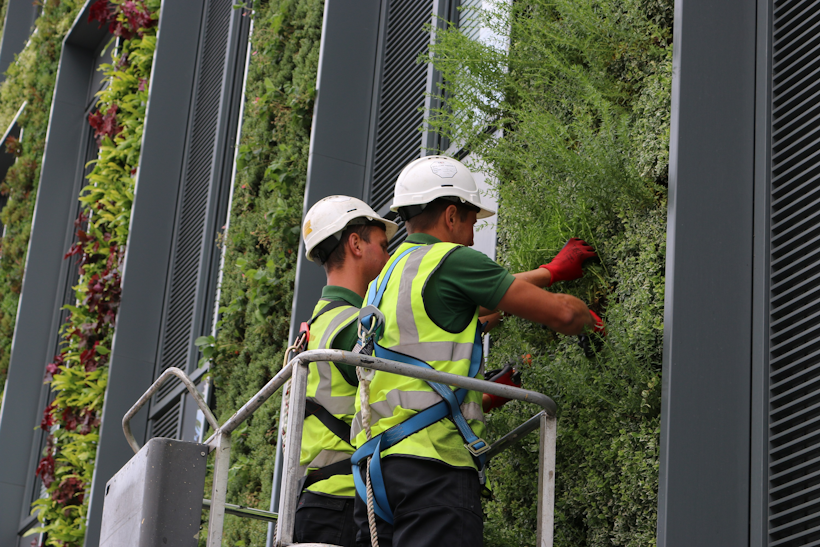
4. What lessons have we learnt from previous living wall projects?
A lot of lessons have been learnt since we began experimenting with living wall systems back in the 2000s. Here are some we’ve learnt along the way, so you can avoid making the same mistakes:
- Make sure you do your research and choose the right system for the project. Are you looking to create something temporary or for long-term? Is it for environmental reasons, to make a social impact or purely for aesthetics? Different systems are suitable for different applications. For example, pocket planters are best for smaller, short-term projects, whereas the Viritopia Living Wall system (modular, based on soil) is ideal for larger projects that are intended to last forever, as economies of scale apply, and the plants are growing in their natural growing medium, improving resilience.
- What plants are you designing with? Plant choice can make or break a living wall project. Consider light levels, exposure to wind and sun, where the wall is facing (the aspect) and the general climatic conditions. Also think ahead: will there be something implemented after the living wall is installed that will change the conditions? For example, will trees be planted in front of the wall after the installation, creating a much shadier area?
_xqxbu.jpg?w=820&q=90&auto=format&fit=crop&crop=edges,focalpoint&fm=png)
- Substrate choice. Although it is usually hidden, the choice of substrate (what the plants are growing in) is as important as the plant choice. Consider the region you’re in, for example the substrate that would work for living walls in the UK would be different to one that would work in Sweden or in Dubai. Do you want the living wall to be an environmental asset? How much maintenance and irrigation are you planning for? A natural substrate like soil not only supports the local environment, but it’s what the plants are used to, which means less nutrients need to be pumped in to keep them alive and healthy, and therefore there is less maintenance, compared to man-made substrate such as rock wool.
- Irrigation & water management. Water filtration plays a big part in the wall’s irrigation. If not filtered correctly, pollutants can cause contamination to the façade, which won’t be good news for your living wall. Similarly, if there’s an uneven spread of water across the irrigation system, plants may begin to fail. For large walls, multiple watering zones can be designed within the irrigation systems to avoid uneven watering. It’s imperative to determine the water source for the living wall and if water is to be recirculated.
- Probably the most obvious point: maintenance is essential for any living wall. It’s extremely important to understand and keep on top of plant health, as failing to notice signs of unhappy plants can be detrimental. Your contracted maintenance partner should also be able to manage the health of plants, the water content, and ensure correct horticultural husbandry at the appropriate time of year. Before your maintenance strategy is thought out, though, there is one vital point you must confirm, and that is: are you able to access the living wall for maintenance? Without an access method, you can’t provide the maintenance a living wall needs to exist.
- Look out! There may be obstacles. We’ve experienced the fall-out of not having the full picture at the start of a project. In one case, it was decided to have trees planted directly in front of the living wall, but this wasn’t shown in any designs. We designed the living wall for the space as we knew it: with dappled sunlight for most of the day. But once the trees were in, they completely shaded the lower 3 metres of the living walls, causing the plants to fail. Essentially, a holistic approach must be taken for the planning, installation, and on-going care of all living walls. If everyone works together, highlighting any potential obstacles along the way, there will be no surprises later down the line - everything will be smooth from start to finish, and your living wall will blossom for the appreciation of many.
This blog on ‘What could go wrong with a living wall’ goes into more detail on each of these points listed above, so if you’d like to learn more, we’d recommend having a read here.
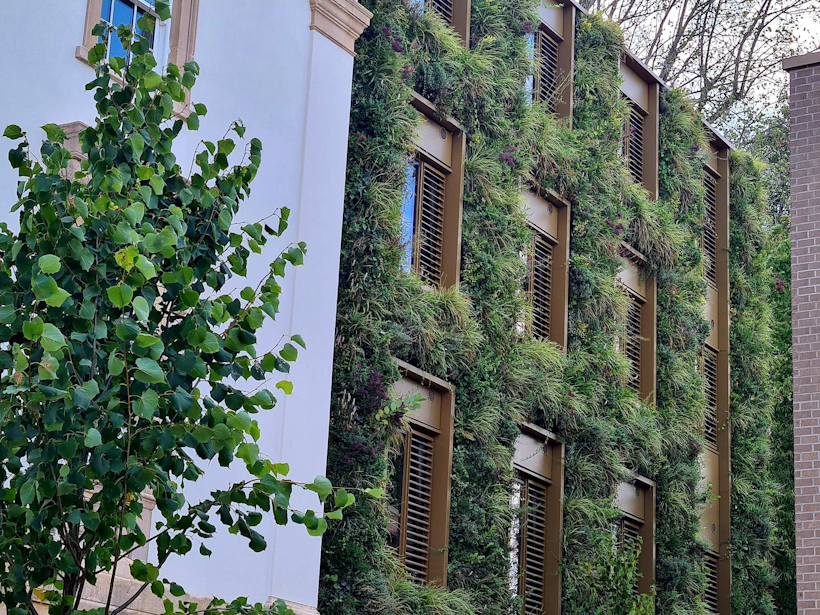
5. Can rainwater be used to irrigate a living wall?
Yes, rainwater can be used to irrigate a living wall. We call this rainwater harvesting. However, it is something to be discussed as early as possible in the project, as how the rainwater is collected and fed into the irrigation system needs to be planned out and integrated into designs.
6. Can water be recycled from the living wall?
If the irrigation is calibrated correctly there shouldn’t be enough water coming out the wall to justify recycling.
7. Can a living wall be installed on a north facing façade?
A living wall can be installed on a north-facing façade, as shown at United Caps and most of the high walk at London Wall Place. It’s simply a case of designing with shade-loving plant species and irrigating the soil and plants to suit.
8. Can a living wall be installed in a saline environment?
A living wall can be installed in a saline environment. Once again it’s down to design and the maintenance schedule. Ensure the plants and soil are suited to the conditions, and the maintenance schedule is appropriate, and your living wall will be kept in optimum health. In fact, our living wall at Venue Cymru is a perfect example of that, where it’s facing the sea.
9. What’s required for maintaining the wall and how often do you visit?
The maintenance programme of a living wall is different for every project. However, what is carried out throughout is consistent. Maintenance visits take place typically monthly, but can be fortnightly, depending on the client’s requirements. These include a visual inspection, adjusting the irrigation levels if necessary and ensuring the soil and plants are in full health.
Horticultural husbandry visits are carried out twice a year, and are more intensive. These can include checking for pest and disease, trimming and pruning, applying biological control through the irrigation system or replacing plants where necessary.
For a full maintenance guide and schedule example, please get in touch and we’ll share.
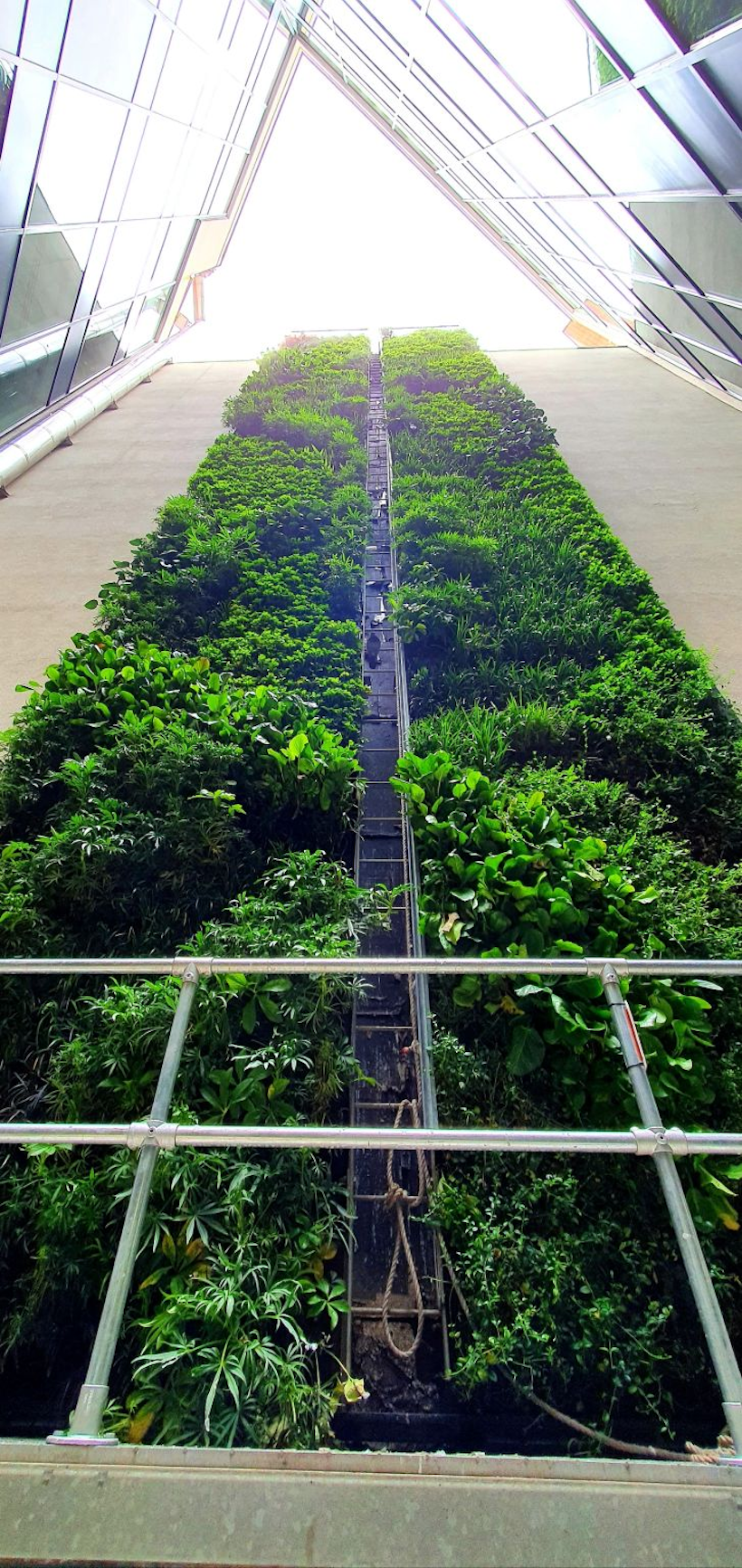
10. Does Viritopia provide a plant palette or plant list for the living wall?
We do provide a full planting design service, but we’re also happy to review any plant lists developed by others.
11. Is there a maximum height a living wall can be installed?
There is no maximum height to which a living wall can be installed, however there are limiting factors such as fire regulations and access.
12. How can we ensure plants in a living wall are able to grow at a high level?
To ensure your living wall plants can grow at a high level, you need to focus on selecting the right species for the location, for example catering for greater exposure to wind and sun. As always, it’s down to plant selection and design.
13. Does the substrate in a living wall ever need to be replaced?
The only time the substrate in a green wall will need to be replaced is when we replace a plant. In this case we add the substrate removed with the plant back in. We allow for 5% of plants being replaced every year under maintenance (due to climate change and ageing).
14. What is the warranty on a living wall?
The warranty on the Viritopia Living Wall System is 12 months from the original date of installation. This includes the Viritopia Living Wall module and the irrigation equipment. For more information on our warranty conditions, please get in touch!
15. How much does maintenance cost for a living wall and does it include access equipment?
The maintenance cost of a living wall is approximately 10-12% of the original cost of the installation, per year. This cost does include access equipment.
_opxoz.jpg?w=820&q=90&auto=format&fit=crop&crop=edges,focalpoint&fm=png)
16. What access is needed for maintenance on a living wall?
The access requirements for maintenance depend on the living wall and location. For any living wall over 6 metres high, extra equipment is required for the twice-yearly horticultural husbandry visits. This could be a cherry picker, scissor lift, scaffold tower, spider lift or even access by abseil.
17. Is the maintenance of a living wall a disruption to the end client?
We work with the client to schedule the best times for maintenance to minimise any disruption. For example, if the living wall is on a high street or in a shopping centre, we could carry out our visits in the early hours or at night to limit disruption during the day. A good example of this is the project at M&S Cheshire, where we have multiple living walls in the car park. All our visits are carried out between 4-7am to limit disruption to shoppers and workers.
18. Does a living wall have to have an irrigation system?
As our living walls are natural (organic soil substrate and real plants) and are essentially vertical gardens, they do need water just as any plant or garden needs water. As living walls are vertical, the irrigation of them happens a little differently to how you’d water a pot plant or your garden. Therefore with every project we install an irrigation system, which feeds water into the soil through a dripper pipe, running along the top of every module. This ensures healthy growth of the plants.
19. How do we install living walls outside the UK?
To install living walls outside of the UK, we either supervise a certified partners team or carry out the works ourselves. This does depend on the location, for example in Australia we have a certified partner who’d carry out the work under our remote supervision, whereas in France and Switzerland, we have installed several living walls ourselves.
20. Does the living wall create an insulation layer on the façade?
A living wall does act as an additional layer of insulation on a façade, as the soil especially is effective at absorbing heat. However, living walls cannot be given a U-Value, so while they are proven to have insulating properties, you cannot include this in your calculations.
Have we answered all your questions about living walls?
We’re here to talk if you have any questions or would like more information on living walls and our process that turns your designs into a reality. Email us at enquiries@ans.global or call +44 1243 545818 to start a conversation.
Other resources you may be interested in:
Blog: Contractors: Your top 20 living wall questions
Flipbook: The 2022 Storybook
_hksxw.jpg?w=4000&q=90&auto=format&fit=crop&crop=edges,focalpoint&fm=png)
